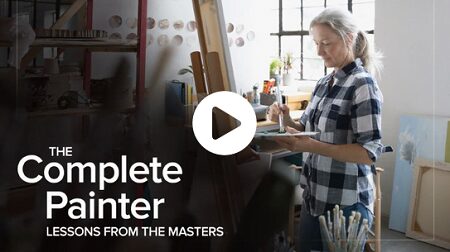
TTC – The Complete Painter | 10.44 GB
The novice will learn the fundamentals of oil painting, from choosing paints and brushes to composition, to a wide variety of specific painting techniques. The experienced painter will gain greater knowledge of oil paints, mediums, lighting, color, and structure. The course includes hands-on experiences for all students, from making your own pigment and paint to copying the methods and compositional choices of the great masters.
In The Complete Painter: Lessons from the Masters, you’ll learn to paint using the same steps taught at the best art schools around the country. Your teacher, David Brody, award-winning Professor of Painting and Drawing at of the University of Washington, begins with the basics, taking you on a fascinating deep dive into the physical properties of oil paint itself, including how to work safely with hazardous materials. From there, you’ll move into the study of marks, lines, brushstrokes, and edges; value, color, and palettes; and how to prepare your canvases and rigid supports-including how to transfer the required underdrawings that are provided in your course guidebook. Next, you’ll study techniques by copying from some of the world’s most iconic paintings.
Throughout this course, your professor guides you in your work, painting right along with you during the exercises-illustrating everything from how he mixes and thins his paints to paint application and removal. But this is not a paint-by-numbers course, nor will you see your professor start and finish paintings in real-time. This is a course for those who are motivated and energized about learning to paint, for those who understand that acquiring a depth of “behind-the-scenes” knowledge will be more valuable in the long run than mimicking every stroke of a teacher.
Course Organization
The Complete Painter: Lessons from the Masters includes several, distinct types of lessons, all of which come together to provide college-level expertise about the history, materials, and techniques of oil painting:
Materials. You’ll learn about the real “must-haves” for your workspace-paper, pencils, additives, brushes, and the six specific tubes of paint you’ll need for your first palette. You’ll learn the difference between flexible and rigid supports, how to work with proportional dividers, and how to best light your workspace.
Palettes. Just as a chef can’t include every spice in any one recipe, a painter must limit color to create a unique work. You’ll learn to work with some of the classic restricted palettes-grisaille, brunaille, and earth-tone-as well as a more expansive palette toward the end of the course.
Exercises. You’ll have many opportunities to practice basic painting techniques such as lines, marks, and shapes, as well as skills related to ground, balance, space, and more.
Projects. Once you have your materials, understand your palette options, and have practiced a great variety of techniques, you will move on to larger projects. Your professor leaves you with some suggestions for creating projects of your own. And, you’ll certainly be ready for the challenge!
In the Grand Tradition of Copying the Masters
The idea of “copying” someone else’s work can carry a negative connotation. But for many hundreds of years, painters have known that if they wanted to paint like the best, they needed to study the best. The Louvre opened its doors to copyists more than 225 years ago and continues a formal and tightly regulated program for copyists today. Cézanne is quoted as having said, “The Louvre is the book from which we learn to read.” Chagall, Dali, Degas, Picasso certainly agreed-Louvre copyists, all.
Continuing in that grand tradition, this course will take you on a deep dive into some of the most iconic works of Western art. You, too, can discover how the masters worked, studying characteristics of their paintings from composition to value to brush strokes. You’ll consider:
The Ballerina by Degas. You’ll analyze a great range of mark making, from brushwork to scratched hatchings. You’ll learn first-hand the value of both adding and removing paint to achieve a desired texture.
Still Life by Morandi. You’ll study depth and focus without the highlight of chiaroscuro, as Morandi hovered between two and three dimensions. As you explore how some of his objects seem to “dissolve,” you’ll learn new ways to work with edges.
The Scream by Munch. You’ll see that even very representational paintings are not mere assemblages of rendered objects. Instead, they’re highly organized groupings of interlocking shapes. And although many assume this was created in a fit of emotion, you’ll learn how meticulously Munch planned this work-over a period of 19 years.
Guernica by Picasso. You’ll learn how powerful even the most limited of palettes can be. In this large and formidable painting, the drama is enhanced by the ancient monochrome technique known as grisaille. And although Picasso’s individual elements are moder-and even shocking-their composition is classical and symmetric; almost every element on the left is answered by a specific element on the right.
The Last Supper by Leonardo. By studying the intricate geometric composition of this work, you’ll begin to see the underlying formation that binds its elements together-the rectangle’s armature. You’ll begin to appreciate the way the armature directs the painting’s composition, a composition that artists have used for many hundreds of years.
Make Your Own Materials
Beyond the paintings and technical exercises, The Complete Painter: Lessons from the Masters gives you many opportunities to dig in and create the tools and mediums that painters have been making for centuries. Although you can certainly buy all the materials, by learning how to make them, you’ll develop a deeper understanding of their functionality, as well as be able to create them to your exact specifications. Among many other materials, this course provides step-by-step instructions for making:
Damar varnish. You can easily make this varnish from damar crystals and turpentine.
Flexible supports. Learn how to make your own supports from the purchase of the linen and stretchers to stretching the linen over the frame, and making your own rabbit-hide glue to size the linen.
Gesso. Making your own traditional gesso from chalk, white pigment, glue, and water takes a bit of time, but it provides a beautiful, very smooth, white surface for painting on rigid supports.
Painting table and brush table. Step-by-step directions for building these two tables from ¾-inch plywood can be found in the course guidebook. While they take some time to build, they’ll provide all the support you’ll need for your work. They also provide the convenience of having your materials protected, and having them exactly where you need them every time.
The Complete Painter: Lessons from the Masters is a robust and energetic guide to oil painting for those who have always been enamored of this skill, but were afraid to give it a try. With your professor’s easy-going manner, calm and clear instruction, and obvious love of the subject, you’ll be painting in no time!
Homepage:
https://www.thegreatcourses.com/courses/the-complete-painter-lessons-from-the-masters





